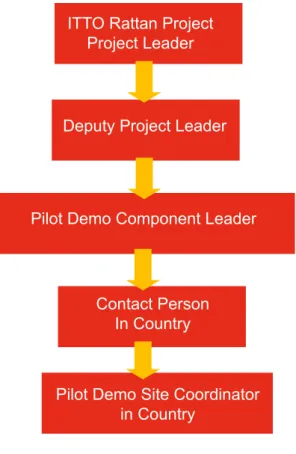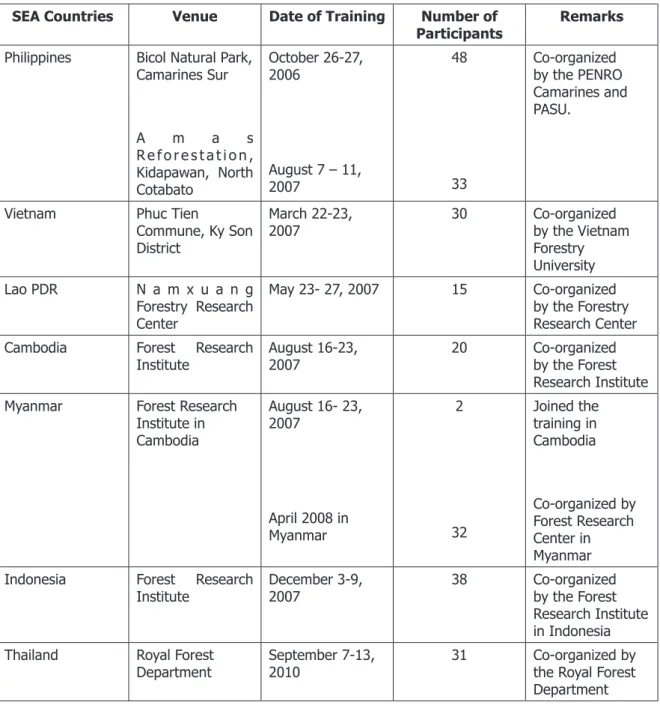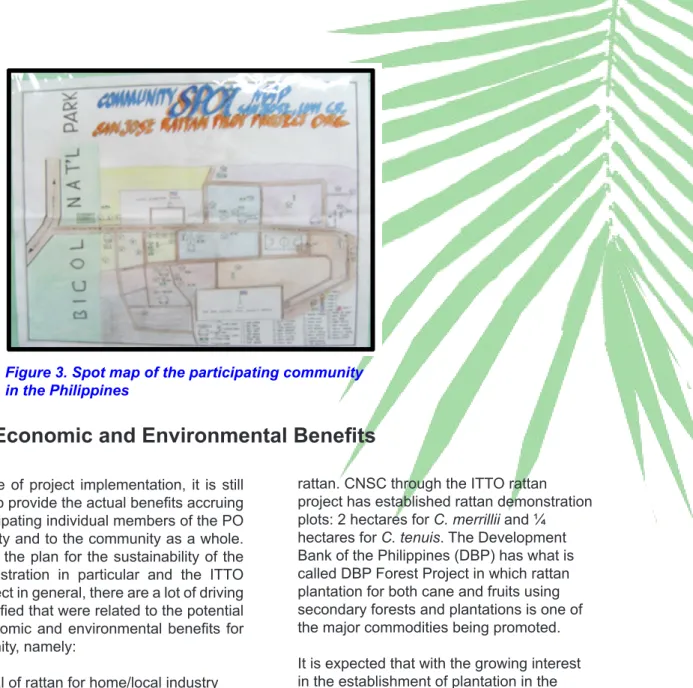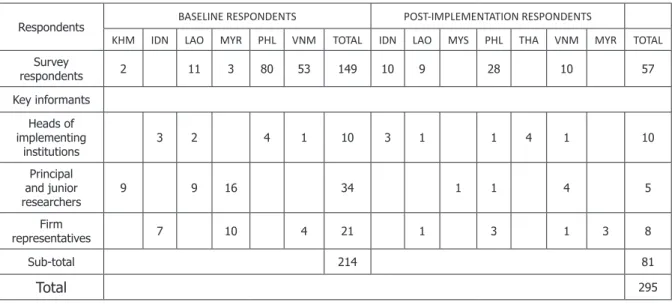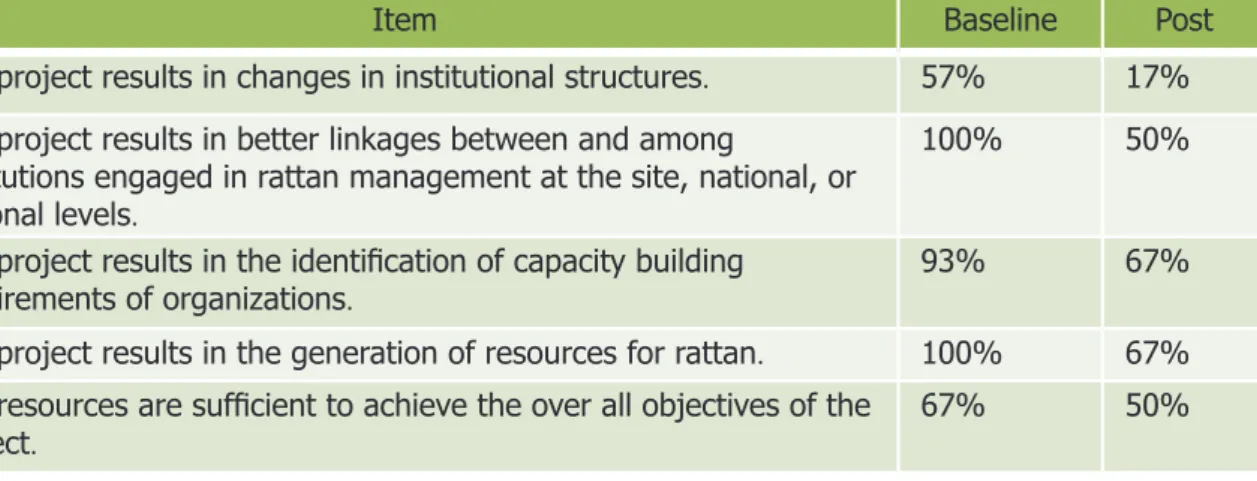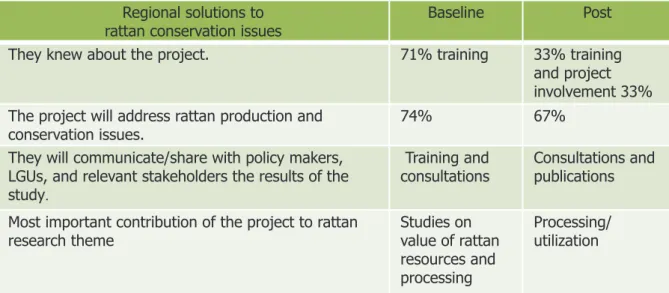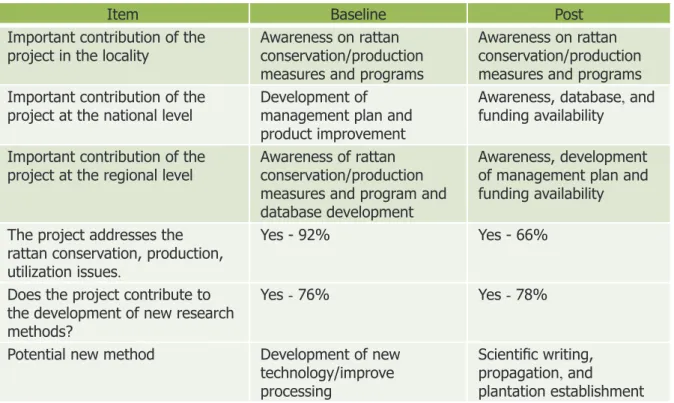This conference is the culminating activity of the ITTO-funded project on demonstration and application of production and utilization technologies for sustainable development of rattan in the ASEAN region. A research, development and extension (RDE) agenda for the development of the rattan sector in the next decade will be proposed.
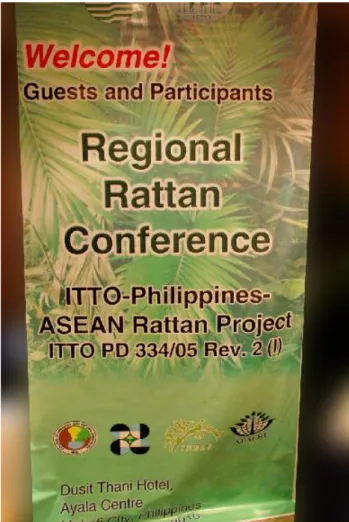
Mr. Li Qiang
Otherwise, this last major activity of the ITTO-Philippines- ASEAN Rattan Project will not materialize. However, weaknesses such as limited information on production and utilization technologies, contribution to socio-economic aspects, as well as cooperation between ASEAN countries have generated the urgent need and concern for the development of the rattan sector and cooperative action in this region.
Dr. Coosje Hoogendoorn
KEYNOTE ADDRESS
The International Union for Conservation of Nature and Natural Resources or IUCN has listed 117 species of creeping palm as threatened to some extent. Sustainable management of rattan resources and sustainable development of the rattan industry requires striking a balance between resource use and conservation to ensure high levels of development.
TECHNICAL
PRESENTATION
Rattans
Sources of new species
Rate of discovery
Problems in Calaminae
Solution
Conclusions
Source for the future
OPEN FORUM
Issues in taxonomy
Progress on taxonomy of rattans
Status of known species
Ever changing names
COUNTRY REPORTS
CAMBODIA
Mr. Chhang Phourin
INDONESIA
Dr. Bambang Wiyono
LAO PDR
Mr. Sounthone Ketphanh
The rattan pilot demonstration was successfully carried out through the active cooperation and participation of the local population. The growth performance of the rattan species was observed to vary depending on the geographical location where they were planted.
Rattan by products: economic and medicinal values and market prospects
Monitoring the growth and yield of rattan planted for both sugarcane and shoot production and investigating the characteristics and uses of rattan species were recommended. So apart from the canes, and with the prospect of being able to collect from existing plantations, what is the future of the rattan plantations.
Rattan and biodiversity
The point is that collecting from the wild after the plantation makes a big difference in the viability of rattan. In fact, a person could earn a lot because the Land Bank of the Philippines had a project where the planting of rattan for edible fruits was promoted.
Rattan and climate change
Hoogendoorn: It is possible to harvest fruits, shoots and canes from different rattan species. Therefore, more research needs to be done to evaluate their food value and determine the value chain.
After the demo project, what is next?
MYANMAR
PHILIPPINES
Amas, Kidapawan City Dr. Bighani Manipula
Length of time before communities can harvest
Effect of light on rattan growth
Species selection
After the pilot project is completed, it is important to consider the end products that each country prefers when determining the type of rattan to be used in future projects. Dransfield: Some genetic work on different species is suggested to shed some light on the matter.
Ownership of the plantation and sustainability
There really wasn't a strict procedure on what species to plant based on the number of years it takes for rattan to bear fruit. Manipula: The behavior of planting material from seeds is very variable compared to that from tissue culture.
Seed exchanges
BOOK LAUNCHING
A Field Guide
The ASEAN Rattans
Commendations and challenges
Technical paper and country reports
THAILAND
VIETNAM
Ms. Do Thi Ngoc Bich
Introduction
This special paper presents the ITTO rattan project's efforts to reach out to local communities and leverage their participation for their own economic benefits despite environmental concerns. More specifically, the pilot demonstration component of the IITO project is highlighted as this is the more direct community approach to promoting rattan as an economic commodity and at the same time a potential contributing resource for environmental prosperity and biodiversity conservation.
The Rattan Pilot Demonstration
Memorandum of Agreement between the Project and the
Take-off Points for the Pilot Demonstration
Selection of Sites for the Pilot Demonstration
Short Listing of Potential Sites for the Pilot Demonstration
Activities Related to the Selection of Sites
Only the consent of the head of the municipality or village with a suitable allocation of the forest was requested, so coordination and location selection were much easier. Thus, the decision on the use of the land was almost entirely in the hands of the land owners in the village. According to the village leader, it is important that the majority in the community is aware of the demo project and its goals and importance, especially for the local economy and environment.
Final Selection of Site for the Pilot Demonstration
However, the village leaders have great influence on the project, which requires the participation of community people. In Myanmar, land owned by the government and managed by the Forest Research Institute was used for the pilot demonstration. Use the lands that were previously used for rice production, but due to constant flooding, alternative uses of the land were sought. Table 1.
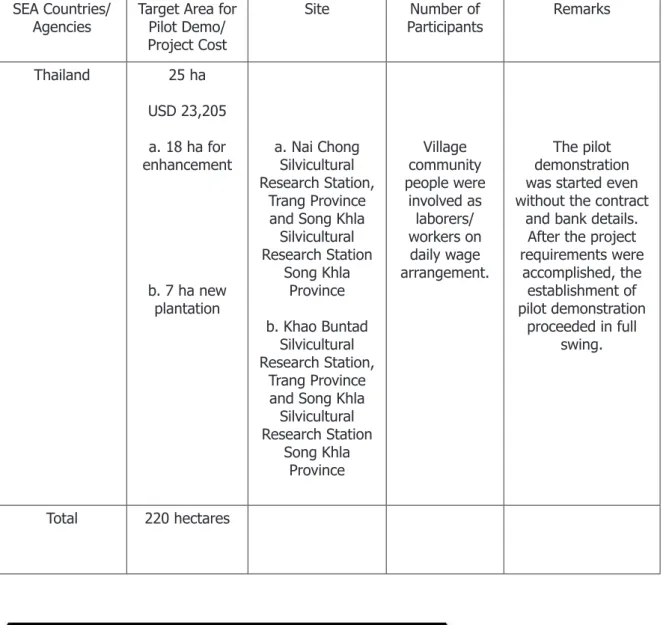
Organizing and Training the Selected Community
Community Action Planning Workshop
Establishment of Rattan Pilot Demonstration
Rattan planting will take place in the rainy season (early July). The old plantation has been planted Calamus rudentum and C. 3 ha New plantation the area has been selected in the old plantation of Hopea ordorata, Dipterocarp spp. Linear planting on both sides of the creek leading to Bokor Natural Park and block planting in the lower part of the park were done by the participating community people.
Social, Economic and Environmental Benefits
Enhanced Community Involvement (Community Pride) - The community's success in establishing rattan plantations as an economic activity and as a strategy for ecological improvement is not only becoming known in their own community. The community becomes the main producer of bamboo and rattan plant material which provided a sustainable source of income for the community. It is more likely that the community engaged in rattan trial demonstration plantations will reap the same rewards and incentives.
Restraining Forces on the Sustainability of the
Facilities - Financing and credit facilities are not available in most ASEAN countries providing financial support, especially for rattan production. This is now being experienced in many parts of the country and other participating SEA countries as well. Policy/Administrative Requirements for Harvesting (RUP) and Transportation - The bureaucratic process of obtaining the resource utilization permit (RUP) from the DENR is one of the most tedious processes an individual, group or community can experience.
The Need for Sustainability Plan for the Pilot Demonstration
In the Philippines, for example, many bills have been introduced in Congress and the Senate to develop bamboo or rattan and other non-woody plants. For the rattan-based industry, however, these financing and credit options are available because the sector has assets that are used as collateral. It is more discouraging during the transportation of raw rattan from the farm to the market due to so many checkpoints operated by the DENR, LTO, police or other unauthorized groups.
Philippine Case
Due to the high potential of growing rattan as an alternative livelihood, the project was readily accepted by the villagers. As the participating farmers own the land, almost all the economic benefits will therefore accrue to them. As a matter of making the other farmers/villagers aware of the rattan growing in the area, coordination was made with the village leader.
Cambodia, Myanmar,
In Kidapawan, South Cotabato, on the other hand, villagers located near the Amas Reforestation project which has intercropping rattan (especially Palasan, Calamus merrillii), have organized into the Amas Community-Based Rattan Growers Association (ACBRGA). so that they can participate in the growth of rattan in the area. This association was used to make their application for the right to manage the plantation not only for cane but also for seed production. Officials of the DENR- Region 12 have assured that the organization will be granted the right over the rattan resources for an acceptable stay based on existing DENR policies.
Indonesia, and Thailand Cases
Vietnam Case
Maintenance and monitoring of the plantation by the operating PO The most important sustainability strategy is that the PO takes ownership of the project. This would ensure that the maintenance and monitoring of the plantation will be carried out by the PO. The project should also be integrated into the regular activities program of the CENRO of the DENR.
Policy issues
Cost efficiency of projects
Use of proper scientific names
Research Areas
Eight research projects on plantation and utilization funded by ITTO-Philippines-ASEAN Rattan Project
Previous RDE Initiatives on Rattan
Concerns
Desired RDE Actions for sustainability
Priorities
Need for certification
PRESENTATION OF RESEARCH
Irawan W. Kusuma and Akhmad Wijaya
These were compiled and analyzed for the subsequent preparation of the draft harmonized classification system for rattan for the ASEAN region. In Indonesia, dragon's blood resin is made from the rattan fruits of the genus Daemonorops, locally known as djernang. Based on the dirt content, this resin has met the requirement of the second grade in the Indonesian National Dragon Blood Standard.
Dragon blood extraction
Plant-derived preservatives
Grading rules for rattan
Isozyme analysis
PRESENTATION OF RESEARCH (continued )
Fui Ree Chia
Mr. Nguyen Huu Cuong
Dr. Bighani Manipula
IMPACT
ASSESSMENT
Why an impact assessment?
Objectives
Surveys and interviews were conducted by project staff in collaboration with colleagues in the field. The policy-making indicators included a set of questions related to identifying current issues in the sustainable management of rattan resources and what research can do to address them. The management indicators consisted of a series of questions related to the improvement of rattan management by stakeholders.
Findings
The study used qualitative and quantitative methods to assess the impact of the project and its components/activities as a basis for better project management in the future. The project results in changes in institutional structures on the ground, national and regional level, better connections, capacity building, resource generation, reorganization of research methods. The majority of baseline respondents think that project resources are sufficient, while only 50 percent of post-survey respondents share the same view.

Data accuracy and analysis
Data gaps and sources
Sustainability of the database
PROJECT PROPOSAL PRESENTATION
ITTO Rattan Team
- Relevance of the Action
- Objectives
- Project Components
- EXPECTED OUTPUTS
The scheme developed by the ITTO-Philippines-ASEAN Rattan Project will be implemented in this project. Incentive to the local communities to grow seedlings that will be used in the plantation will be provided. Incentive scheme developed by the ITTO-Philippines- ASEAN Rattan Project will be used throughout the plantation development phase.
Change in title
Local and international markets for primary processed and finished products will be acquired to increase the viability of target countries. Based on the literature and inventory of existing rattan species found in the target countries, a table book will be prepared and documented. The socio-cultural and industrial use of these species will also be presented in the coffee table book.
Project focus and content
Likewise, the book will serve as valuable information to promote the development of rattan and in craft policy for conservation, management and sustainable use. Gasgonia: Can the project also consider transporting raw materials from the farms to the markets or processing centers.
Don’t start from zero; link up
2010 DECLARATION OF COMMITMENT
Participatory Exercise
Final Version of Pledge of Commitment
CLOSING
PROGRAMME
Rattan Diversity: How much we know and how much there is to discover.
August 31(Tuesday) 8:00-8:15 Registration
PRODUCTION TEAM
